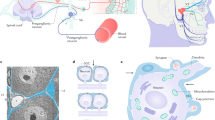Immunohistochemical reaction to glial fibrillar acid protein (GFAP) is widely used for identification of activated satellite cells in sensory ganglia. We used this marker in studies of satellite cells activation in dorsal root ganglia during aging and under conditions of experimental systemic inflammation: in young (4 months) and aged (18-19 months) rats and animals with experimental LPS-induced systemic inflammation. The number of GFAP+ satellite cells increased significantly after parenteral injection of LPS and during aging, which can indicate similarity of mechanisms of reactive glial changes during aging and systemic inflammation.
Similar content being viewed by others
References
Kolos EA, Korzhevskii DE. Activation of Microglyocytes in the Anterior Horns of Rat Spinal Cord After Administration of Bacterial Lipopolysaccharide. Bull. Exp. Biol. Med. 2017;163(4):515-518. doi: https://doi.org/10.1007/s10517-017-3841-8
Belzer V, Hanani M. Nitric oxide as a messenger between neurons and satellite glial cells in dorsal root ganglia. Glia. 2019;67(7):1296-1307.
Blum E, Procacci P, Conte V, Hanani M. Systemic inflammation alters satellite glial cell function and structure. A possible contribution to pain. Neuroscience. 2014;274:209-217.
Blum E, Procacci P, Conte V, Sartori P, Hanani M. Long term effects of lipopolysaccharide on satellite glial cells in mouse dorsal root ganglia. Exp. Cell Res. 2017;350(1):236-241.
Chung HY, Kim DH, Lee EK, Chung KW, Chung S, Lee B, Seo AY, Chung JH, Jung YS, Im E, Lee J, Kim ND, Choi YJ, Im DS, Yu BP. Redefining chronic inflammation in aging and age-related diseases: proposal of the senoinflammation concept. Aging Dis. 2019;10(2):367-382.
Feldman-Goriachnik R, Belzer V, Hanani M. Systemic inflammation activates satellite glial cells in the mouse nodose ganglion and alters their functions. Glia. 2015;63(11):2121-2132.
Franceschi C, Capri M, Monti D, Giunta S, Olivieri F, Sevini F, Panourgia MP, Invidia L, Celani L, Scurti M, Cevenini E, Castellani GC, Salvioli S. Inflammaging and anti-inflammaging: a systemic perspective on aging and longevity emerged from studies in humans. Mech. Ageing Dev. 2007;128(1):92-105.
Hanani M. Satellite glial cells in sensory ganglia: from form to function. Brain Res. Brain Res. Rev. 2005;48(3):457-476.
Hanani M, Blum E, Liu S, Peng L, Liang S. Satellite glial cells in dorsal root ganglia are activated in streptozotocin-treated rodents. J. Cell. Mol. Med. 2014;18(12):2367-2371.
Hung Y, Suzuki K. The pattern recognition receptors and lipopolysaccharides (LPS)-induced systemic inflammation. Int. J. Res. Studies Med. Health Sci. 2017;2(7):1-7.
Michaud M, Balardy L, Moulis G, Gaudin C, Peyrot C, Vellas B, Cesari M, Nourhashemi F. Proinflammatory cytokines, aging, and age-related diseases. J. Am. Med. Dir. Assoc. 2013;14(12):877-882.
Miller KE, Richards BA, Kriebel RM. Glutamine-, glutamine synthetase-, glutamate dehydrogenase- and pyruvate carboxylase-immunoreactivities in the rat dorsal root ganglion and peripheral nerve. Brain Res. 2002;945(2):202-211.
Pannese E. Biology and pathology of perineuronal satellite cells in sensory ganglia. Springer International Publishing, 2018.
Seemann S, Zohles F, Lupp A. Comprehensive comparison of three different animal models for systemic inflammation. J. Biomed. Sci. 2017;24(1):60. doi: https://doi.org/10.1186/s12929-017-0370-8
Xia S, Zhang X, Zheng S, Khanabdali R, Kalionis B, Wu J, Wan W, Tai X. An update on inflamm-aging: mechanisms, prevention, and treatment. J. Immunol. Res. 2016;2016. ID 8426874. doi: https://doi.org/10.1155/2016/8426874
Author information
Authors and Affiliations
Corresponding author
Additional information
Translated from Byulleten’ Eksperimental’noi Biologii i Meditsiny, Vol. 169, No. 5, pp. 596-599, May, 2020
Rights and permissions
About this article
Cite this article
Kolos, E.A., Korzhevskii, D.E. Immunohistological Detection of Active Satellite Cellsin Rat Dorsal Root Ganglia after Parenteral Administration of Lipopolysaccharide and during Aging. Bull Exp Biol Med 169, 665–668 (2020). https://doi.org/10.1007/s10517-020-04950-2
Received:
Published:
Issue Date:
DOI: https://doi.org/10.1007/s10517-020-04950-2




